The orbiters and the launch vehicle
As a whole the 2 shuttles have the same dimensions, mainly because Buran was made to be a counterpart of the STS Shuttle. But Buran is a little bit lighter than the STS orbiter (62 tons instead of 68 tons). The major difference is the rear of the shuttles, STS have 3 powerful engines SSME for the lift-off whereas Buran has no. This due to an important difference in the design process. Buran was only a payload of the Energia LV so its engines was only for the orbit trajectories. The STS Shuttle has powerful engines because they are used for the putting into orbit, but once there they are useless.
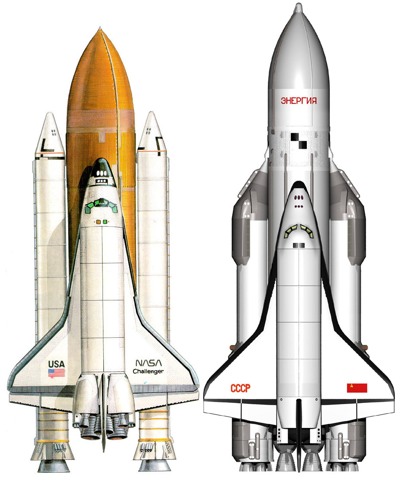
This difference lead to another one, Buran needed a launch vehicle whereas the STS Shuttle is its own launcher. So the engines are on the Energia launcher. The scheme of Energia is nearly the same of STS. A central block (2nd stage) with strap on boosters on its side (1st stage). The 1st stage is made of 4 boosters which are burning fuel and oxygen instead of solid propellant. This is a major difference in design because liquid propellants are more powerful that solid (chemical), and the engines can be easily controlled (increase or decrease the power, or cutting off), so in case of emergency they can be cut-off and prevent the launcher from explosion.
The dimensions of the launcher are nearly the same (the Energia's boosters are smaller), but because Energia uses liquid propellant it is more powerful than STS. The boosters of Energia are also reusable but they use a totally different scheme. Once they burn all their propellant they are ejected from Energia in pair (to avoid damaging the shuttle), then they are separated. A small parachute is deployed to them down, once the atmosphere is more dense a bigger one is deployed. Finally to slow down near touch down retro-rockets are turned on and landing gears are deployed to land them safe. For STS the boosters are ejected after 2 min burn. Then a parachute slow them down until they reach the Ocean where they sea land.

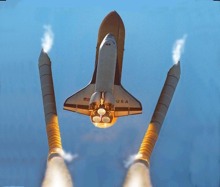
Another big difference is that Buran was made to be fully automated or remote controlled, in flight and even in working in orbit (for manipulating payloads). This functionality lead to big differences in the development of the shuttle and the launcher.
The cockpit - Nose
The cabine of the 2 shuttles have some important differences. First, the cockpit of Buran is fixed on shock-absorbers inside the fuselage, to decrease the vibrations during the flight, and the front thrusters block is more voluminous. The front landing gear of the STS orbiter is in the nose under the thrusters block, whereas the Buran's one is a the junction between the cabin and the payload bay, much more on the back, so the STS orbiter is more tilted during the landing.
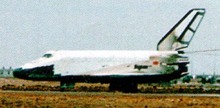
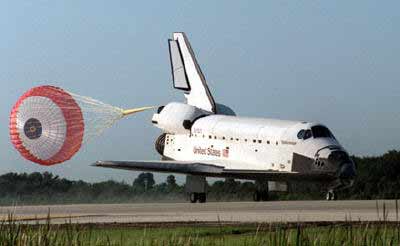
On-board computer
The on-board computers are made on the same principle, an important redundancy, to avoid erros in processing and hardware breakdown. The Buran's computer is cadenced à 4MHz (3 MHz for STS), it is composed of 4 independent units (5 for STS), the dead memory is stored on magnetic tapes, the memory of the Buran's computer is 819 200 words of 32 bits (106 496 words of 16 bits for STS) which give it a better calculation power. The engineers of the STS computer decided to use well known languages such as FORTRAN for coding the algorithme whereas for Buran new computer science languages were developed (high and down level). It's more powerful because it uses all the power of the hardware but needs more time to make the language and needs more time for the engineers and technicians to be fully ready to work on it.
The dashboard
The dashboard of Buran was not complete when it flow on November 15, 1988, so it's not easy to compare it with STS. Due to the automatic functionality it was simpler to the STS one.
The Buran's avionics are clear expression of the Soviets' general preference for functionality, rather than sophistication, in design. Compared to the advanced digital-fly-by-wire controls system of the U.S. Shuttle, the Buran's avionics appear rudimentary. On the Soviet side, the Buran cockpit featured mostly dial instruments, rather than digital displays. The Buran testbed vehicles apparently used an analog version of the flight control system because the digital system was problematic.
The wing
The wings of the two orbiters are strictly the same. They have the same shape, a delta wing with an angle in the leading edge. Elevons at the rear and a protection system to prevent the plasma to come in the structure of the wing.
The payload bay - central part of the fuselage
The payload bays of the two orbiters have the same dimensions and the same function. There is few minors differences in the central part of the fuselage because it's a part where tanks and antennas are stored, so their locations and nature are differents. In the early design of Buran the payload bay doors were in metal (titanium alloy), which is very heavy, but the use of composites materials made it possible to decrease the mass of the doors of 600 kg compared to the metal model.
The remote manipulator system
The Remote Manipulator System is very different in functionality between the two orbiters, but they have nearly the same dimensions the same liberty degrees, tilts angles and strength (payload of approximately 30 tons). The Buran's RMS is 360 kg and the STS's one is 411 kg. Moreover, Buran has two RMS, one on each side of the payload bay, an main RMS and a second in case of failure. The major difference is once again in the automatic functionalities. The Buran's RMS can execute an automatic sequence stored in the computer or can be remotely piloted from Earth by a technician.
Note that the Buran's RMS was not finished for its first flight in 1988. It was planned to be added few years later.
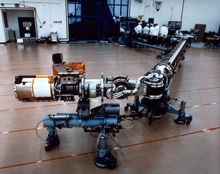
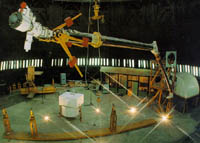
The vertical stabilizer - rear part of the fuselage
The vertical stabilizer is the same for the two orbiters and has the same function, orientating the shuttle during the re-entry phase and aero-brake function.
The parachute was introduced later on the Orbiter (after the accident of Challenger), whereas Buran has one from the start.
The engines
The rear part of the two shuttles are very different. The STS orbiter has three different kind of engines at the rear, the SSME (for putting it into orbit), the OMS for orbit insertion and RCS (steering system) for precision movement once in the working orbit. Buran has only two king of engines, the mains (which use liquid oxygen and kerosene) and the steering system with gazeus oxygen. This major difference make the rear of Buran much more lighter and less complicated to maintain.
Moreover there is no pods (for the OMS) so the engineers decided to put turbojet at the base of the vertical stabilizer to increase the travel distance during the re-entry phase in case Buran miss the entry window. But they were removed for the first flight because the system was not ready yet.
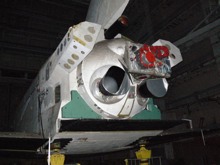
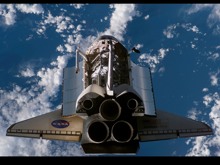
Energy
The energy systems on the orbiters are similar. There is a fuel cell for electricity and Auxiliary Power Units (APU) for the mechanical systems.
The electrical energy is given by a fuel cell, it uses oxygen and hydrogen to generate electricity and produce water for the crew. The americans also used power cells for their Apollo program whereas russians use electrical batteries in that time. But they developed a new fuel cell especially for Buran (from the one they made for their Lunar program). This fuel cell was not installed on the first flight of Buran. The power was given by additional batteries (in the payload bay).
The energy used for aerodynamical mechanisms (vertical stabilizer, elevons, landing gears) is produced by an APU. For both shuttles their is three networks and three APUs working in case of a failure (103 kW of power for the Orbiter, 105 kW for Buran). They both use hydrazine as propellant.
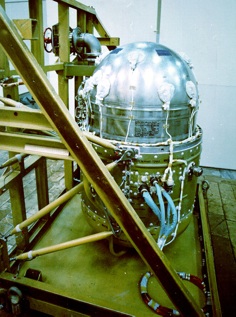
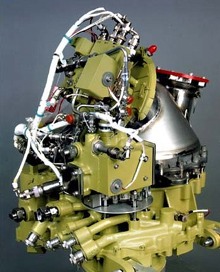
Heat shield
The heat shield is a major part of the space shuttle, it protects it during the re-entry in the dense layers of the atmosphere, because the temperature could grow up to 1200°C.
The heat shield of Buran is made from three kinds of materials, Reinforced Carbon Carbon plates for the nose and the leading edges of the wings, tiles (38600), black ones mainly of the lower part (where heat is high, they can resist until 1650°C) and white tiles on the other parts of the surface of the fuselage. The thermal protection is mainly ensured by the tiles and also by a coat layer between the tiles and the fuselage.
The heat shield of the STS orbiter is composed of 2 types of tiles (black and white) and RCC material for the leading edges of the wings and the nose. The black tiles of the orbiter can resist to 1260°C.
The heat shield is the Achilles' heel of the shuttle. For the STS orbiter the engineers were forced to make another glue to settle the tiles because some of them fell down during the first flight. Moreover, the organisation of the tiles on the surface of the fuselage is very important in comparison of he plasma flow. The engineers working on Buran knew it so developed a very resistive glue (only 7 tiles felt during the first flight) and they assembled the tiles in a particular way. The tile positioning on Buran is different from the American shuttle. On Buran there are no triangular and acute-angled tiles, and all the long slits between the tiles are perpendicular to the plasma flow (see opposite figure). This organization of the tiles makes it possible to reduce aerodynamic turbulences during the flight. As for the nasal part, the elevons and the drift, the tiles are positioned according to a range. For the change of direction of the joints lines pentagonal tiles are introduced, because they do not have acute angles.
Later the american engineers developed a new thermal protection named Advanced Flexible Reusable Surface Insulation (AFRSI), it is a thermal coat much more resistive to hits than the tiles. They use it where the heat is not too important (instead of white tiles), it seems that the soviet engineers developed something similar (as we can see on the picture below) but didn't use it on the fifth shuttles in construction.
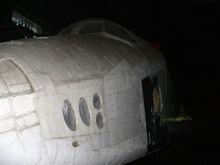
Security
The security was an important part of the process during the development of the two orbiters. The major parts of the avionics systems came from aviation (where it was well tested and approved), main circuits, tubes, wiring are doubled, tripled or even quadrupled (for the on-board computer), so that a hardware failure is practically impossible.
The main advantage of Buran over STS is that is was made from start to be fully automated. So the computer can take decision more quickly than the crew in case of emergency to save the crew and the payload, by reducing thrust or even eject the shuttle (500 scenaries are stored in the computer). If the shuttle is ejected it will return safely in automatic flight to the landing strip. Moreover, the engines of Energia LV use liquid propellant and can be shutdown if wanted.
The pilot and the co-pilot can also be saved by the automatic ejection of their seats during the ascent (from 50 m to 35 km).
Thirdly, the Energiya was an launch vehicle (ELV) but U.S. Shuttle was designed reusability in mind since main engines are in orbiter and the SRBs refurbished after each flight. rationale for reusability was it would enable quicker for launches and then turn, higher flight rates, lower costs per flight. the U.S. Shuttle has achieved the high flight that were envisioned and an expensive way to payloads into space. Whether Soviet decision to go the Energiya ELV booster the most cost-effective is to assess since it flew twice. In addition, to the Soviets' traditional they did not simply an existing rocket, although did closely adapt the orbiter s configuration.
The Soviet Energiya-Buran story is less well known, especially the English language literature a few glossy monographs the Energiya and the separately, they are not analytical. There is a amount of relevant Russian material on the Soviet and some of it in translation. Even in however, there seems to no definitive analytical history the Buran that covers political factors behind its rather than simply the details. This remains as very worthwhile and potentially task for an interested with Russian language skills.

